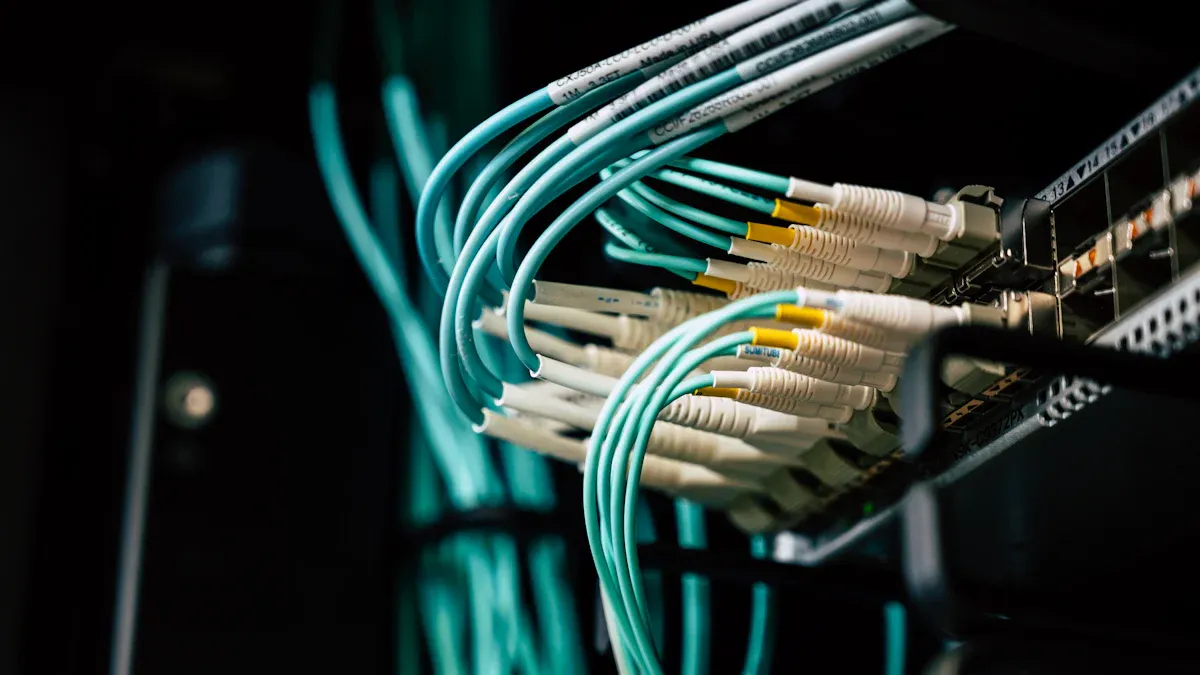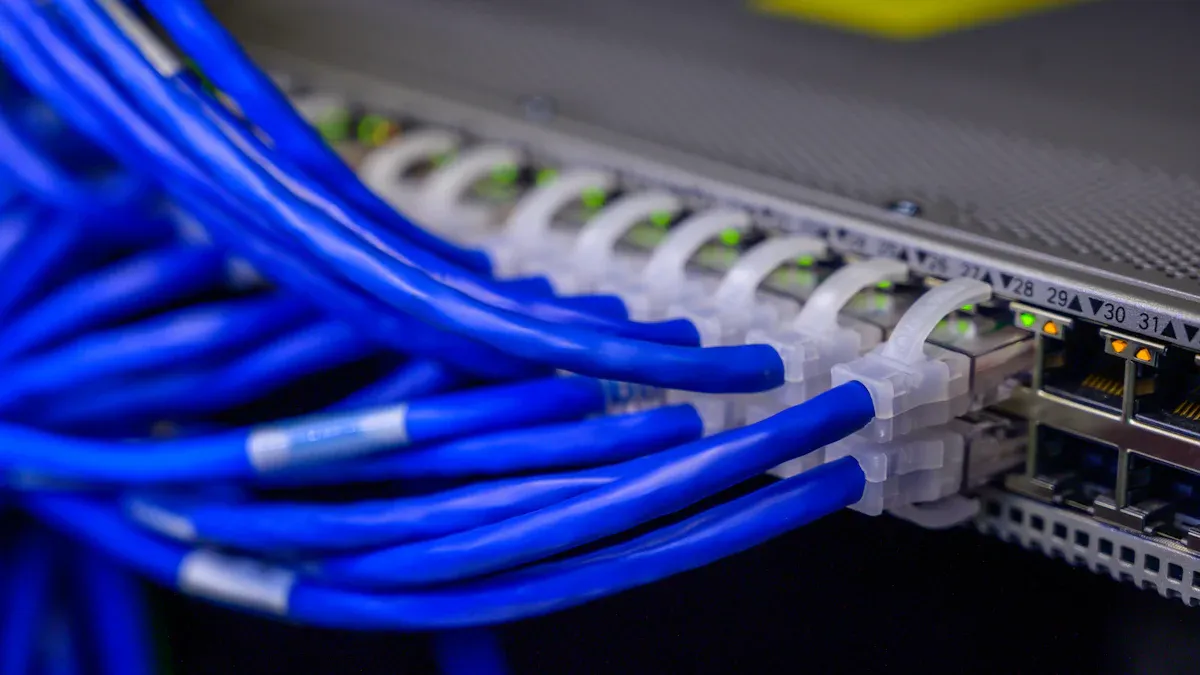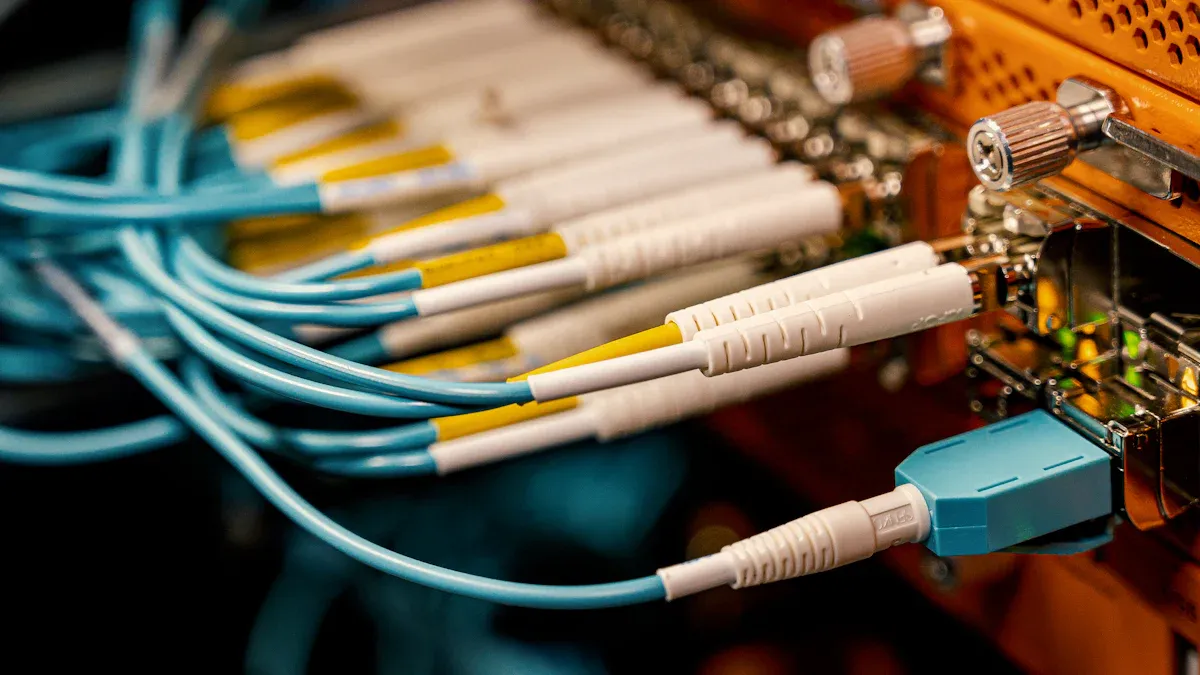
Fiber optic cables revolutionized communication, particularly in the realm of Fiber Optic Cable For Telecom. They utilize thin strands of glass or plastic to transmit data as light pulses, making them faster and more efficient than traditional cables. You rely on fiber optic cable telecom every day for internet connectivity, streaming, and phone calls. In telecom networks, these cables ensure high-speed data transfer over long distances without signal loss. Their durability and resistance to interference make them essential for modern communication systems. With OEM Fiber Optic Cable For Telecom solutions, companies can customize networks to meet specific needs, paving the way for seamless communication.
Key Takeaways
- Fiber optic cables send data using light, so they are faster and better than old copper cables.
- These cables are not affected by electromagnetic interference, keeping connections steady even in tough places.
- Fiber optics are great for long distances, keeping signals strong over hundreds of miles without much loss.
- Using fiber optic cables improves internet speed and makes it more reliable, perfect for streaming and heavy data use.
- Fiber optics are important for future tech like 5G and smart cities, helping create new ideas that make life easier.
What Are Fiber Optic Cables?

Definition and Structure
Fiber optic cables are advanced communication tools that transmit data using light. They consist of thin strands of glass or plastic, each about the thickness of a human hair. These strands are bundled together and protected by layers of coating to ensure durability.
The structure of a fiber optic cable includes three main parts:
- Core: The innermost layer where light travels.
- Cladding: Surrounds the core and reflects light back into it, ensuring efficient transmission.
- Buffer Coating: Protects the cable from damage caused by moisture, heat, or physical stress.
Fiber optic cables rely on the principle of light transmission, making them faster and more reliable than traditional cables.
When you look at their design, you’ll notice how every layer plays a role in maintaining signal quality. This structure allows fiber optic cables to handle high-speed data transfer over long distances without losing quality.
Comparison with Copper Cables
Copper cables were once the backbone of communication networks. They transmit data as electrical signals, which makes them slower and more prone to interference. Fiber optic cables, on the other hand, use light signals, which travel faster and remain unaffected by electromagnetic interference.
Here’s a quick comparison:
| Feature | Fiber Optic Cables | Copper Cables |
|---|---|---|
| Data Transmission | Light signals | Electrical signals |
| Speed | Extremely fast | Slower |
| Interference | Resistant to interference | Prone to interference |
| Distance | Long-distance capability | Limited range |
Fiber optic cables also have a smaller diameter, making them lighter and easier to install. Copper cables, while cheaper initially, require more maintenance due to signal degradation over time.
If you’re looking for a solution for modern telecom networks, fiber optic cables outperform copper cables in almost every aspect.
By choosing Fiber Optic Cable For Telecom, you gain access to faster speeds, better reliability, and a future-proof communication system.
How Fiber Optic Cable For Telecom Works
Data Transmission as Pulses of Light
Fiber optic cables transmit data by converting electrical signals into light pulses. These light pulses travel through the cable’s core, carrying information at incredible speeds. You can think of it as a high-speed highway for data, where light acts as the vehicle.
Each pulse represents a bit of data, either a 1 or a 0, which forms the foundation of digital communication. Devices like lasers or LEDs generate these light pulses. At the receiving end, a photodetector converts the light back into electrical signals that your devices can understand.
Fun Fact: Light in fiber optic cables can travel at nearly 70% of the speed of light in a vacuum!
This method of data transmission makes fiber optic cables far superior to traditional copper cables. It ensures faster speeds and minimal data loss, even over long distances.
Total Internal Reflection
The magic of fiber optic cables lies in a phenomenon called total internal reflection. When light enters the core of the cable, it bounces off the cladding layer repeatedly. This keeps the light confined within the core, allowing it to travel long distances without escaping.
For total internal reflection to occur, the core and cladding must have different refractive indices. The core has a higher refractive index, which bends the light back into the core whenever it tries to escape.
Here’s a simple analogy: Imagine a marble rolling inside a curved tube. The walls of the tube keep the marble from falling out, just like the cladding keeps the light inside the core.
This process ensures that the data carried by the light remains intact, even when the cable bends or twists. It’s one of the reasons why fiber optic cables are so reliable for modern telecom networks.
Role of Repeaters in Long-Distance Communication
While fiber optic cables can transmit data over long distances, the light signal weakens as it travels. To solve this, telecom networks use devices called repeaters. These devices amplify the light signal, ensuring it remains strong and clear over vast distances.
Repeaters work by capturing the weakened light signal, boosting its intensity, and then sending it forward. You’ll find these devices strategically placed along undersea cables and other long-distance fiber optic networks.
Without repeaters, global communication through fiber optic cables wouldn’t be possible. They play a crucial role in maintaining the efficiency of networks like the internet and international phone systems.
By combining advanced technologies like light pulses, total internal reflection, and repeaters, Fiber Optic Cable For Telecom has become the backbone of modern communication. It ensures that you can enjoy fast, reliable, and uninterrupted connectivity, no matter where you are.
Types of Fiber Optic Cables
Single-Mode Fiber
Single-mode fiber is designed for long-distance communication. It has a small core, typically around 9 microns in diameter, which allows only one mode of light to pass through. This focused light path reduces signal loss and ensures high-speed data transmission over vast distances.
You’ll often find single-mode fiber used in applications like undersea cables and large-scale telecom networks. Its ability to handle long-distance communication with minimal interference makes it ideal for connecting cities, countries, and even continents.
Tip: If you’re setting up a network that spans hundreds of miles, single-mode fiber is the best choice for reliable performance.
Multimode Fiber
Multimode fiber, on the other hand, has a larger core—usually around 50 to 62.5 microns. This allows multiple modes of light to travel through the cable simultaneously. While this increases the amount of data it can carry, it also leads to more signal distortion over long distances.
You’ll see multimode fiber in local area networks (LANs) and data centers. It’s perfect for short-distance communication, such as connecting devices within a building or campus. Its lower cost and easier installation make it a popular choice for smaller-scale projects.
Note: Multimode fiber works best for distances under 2 kilometers. Beyond that, signal quality may degrade.
Applications of Each Type
| Fiber Type | Best For | Examples |
|---|---|---|
| Single-Mode Fiber | Long-distance communication | Undersea cables, telecom networks |
| Multimode Fiber | Short-distance, high-data environments | LANs, data centers |
Single-mode fiber excels in scenarios where you need to transmit data over long distances without losing quality. Multimode fiber, however, shines in environments where short-range, high-speed connections are required. By understanding these differences, you can choose the right Fiber Optic Cable For Telecom to meet your specific needs.
Advantages of Fiber Optic Cable For Telecom
Speed and Bandwidth
Fiber optic cables deliver unmatched speed and bandwidth, making them the gold standard for modern telecom networks. These cables transmit data as light, allowing information to travel at incredible speeds. Unlike older technologies, fiber optic cables can handle vast amounts of data simultaneously without slowing down.
For example, streaming high-definition videos, participating in video calls, or downloading large files becomes seamless with fiber optics. You won’t experience the lag or buffering that often occurs with traditional copper cables. This capability ensures that your internet connection remains fast and reliable, even during peak usage times.
Tip: If you need a network that supports high-speed internet and heavy data usage, fiber optic cables are the ideal choice.
Resistance to Electromagnetic Interference
Fiber optic cables are immune to electromagnetic interference (EMI). This means they can maintain a stable connection even in environments with high electrical activity. Copper cables, in contrast, often suffer from signal degradation when exposed to EMI.
You’ll find this feature especially useful in industrial areas, near power lines, or in crowded urban settings. The light-based transmission in fiber optics ensures that your data remains secure and unaffected by external disturbances. This makes fiber optic cables a reliable option for critical telecom applications.
Fun Fact: Fiber optic cables are also resistant to weather-related disruptions, making them more durable in harsh conditions.
Suitability for Long-Distance Transmission
Fiber optic cables excel in long-distance communication. They can transmit data over hundreds of miles without significant signal loss. This is possible because of their advanced design and the use of repeaters to amplify signals when needed.
For instance, undersea fiber optic cables connect continents, enabling global internet and phone services. These cables ensure that you can communicate with anyone, anywhere, without delays or interruptions. Their ability to maintain signal quality over long distances makes them indispensable for modern telecom networks.
Note: Fiber optic cables are the backbone of international communication, supporting everything from online gaming to global business operations.
Applications of Fiber Optic Cable For Telecom

Internet Services
Fiber optic cables have transformed how you access the internet. They provide the backbone for high-speed broadband services, ensuring faster downloads, smoother streaming, and lag-free online gaming. Unlike older technologies, fiber optics can handle large amounts of data without slowing down. This makes them ideal for households and businesses that rely on stable internet connections.
Many internet service providers (ISPs) now use fiber optic networks to deliver gigabit-speed internet. This allows you to enjoy activities like video conferencing or cloud computing without interruptions. Fiber optic cables also support symmetrical upload and download speeds, which is essential for tasks like uploading videos or sharing large files.
Tip: If you want the fastest and most reliable internet, look for providers offering fiber optic connections.
Undersea Cables
Undersea fiber optic cables connect continents and power global communication. These cables lie on the ocean floor, transmitting data across thousands of miles. They enable you to browse websites, make international calls, and stream videos from servers located halfway around the world.
Each undersea cable contains multiple fiber optic strands, allowing it to carry massive amounts of data. Repeaters placed along the cable amplify the light signals, ensuring data reaches its destination without loss. Without these cables, the internet as you know it wouldn’t exist.
Fun Fact: Over 99% of international data traffic travels through undersea cables, not satellites.
Smart Cities and 5G Networks
Fiber optic cables play a critical role in building smart cities and supporting 5G networks. In smart cities, they connect sensors, cameras, and devices, enabling real-time data sharing. This helps improve traffic management, energy efficiency, and public safety.
For 5G networks, fiber optics provide the high-speed backbone needed to handle massive data loads. They ensure low latency, which is crucial for technologies like autonomous vehicles and remote surgeries. By using fiber optic cable for telecom, cities can create smarter, more connected environments for you to live and work in.
Note: Fiber optics are essential for the future of urban development and next-generation wireless networks.
Comparison with Other Technologies
Copper Cables
Copper cables were once the standard for telecom networks. They transmit data as electrical signals, which makes them slower and more prone to interference compared to fiber optic cables. If you’ve ever experienced slow internet speeds or dropped calls, copper cables might have been the culprit.
Here’s why fiber optic cables outperform copper cables:
- Speed: Fiber optic cables transmit data as light, which is faster than electrical signals.
- Interference Resistance: Copper cables are vulnerable to electromagnetic interference, while fiber optics remain unaffected.
- Durability: Fiber optic cables resist weather and environmental damage better than copper cables.
Tip: Copper cables may still work for small-scale networks, but fiber optics are the better choice for high-speed, reliable communication.
Copper cables also have limitations in long-distance transmission. Signal strength weakens over extended distances, requiring frequent boosters. Fiber optic cables, on the other hand, maintain signal quality over much longer distances.
Wireless Data Transmission
Wireless technology has become popular for its convenience. It allows you to connect devices without physical cables. Wi-Fi and cellular networks are examples of wireless data transmission. However, wireless systems rely on radio waves, which can face challenges like interference and limited bandwidth.
Fiber optic cables complement wireless networks by providing the backbone for data transmission. Here’s how they compare:
| Feature | Fiber Optic Cables | Wireless Transmission |
|---|---|---|
| Speed | Extremely fast | Slower |
| Reliability | Highly reliable | Prone to interference |
| Distance | Long-distance capability | Limited range |
Note: Wireless networks are great for mobility, but fiber optics ensure the stability and speed needed for large-scale data transfer.
Fiber optic cables and wireless technologies often work together. Fiber optics handle the heavy lifting for data transmission, while wireless systems provide flexibility for end-user connections. By combining both, telecom networks achieve the best of speed and convenience.
Future Trends in Fiber Optics
Higher Data Rates
Fiber optic technology continues to evolve, pushing the boundaries of data transmission speeds. Researchers are developing advanced techniques to increase the capacity of fiber optic cables. These innovations aim to meet the growing demand for faster internet and higher bandwidth.
You can expect future fiber optic networks to support data rates that are several times faster than current speeds. For example, technologies like Dense Wavelength Division Multiplexing (DWDM) allow multiple light signals to travel through a single fiber. This increases the amount of data the cable can carry without requiring additional infrastructure.
Fun Fact: Some experimental fiber optic systems have already achieved speeds exceeding 1 petabit per second!
Higher data rates will benefit activities like streaming ultra-high-definition videos, using virtual reality, and transferring large files. As these advancements become mainstream, your online experience will become smoother and more efficient.
Integration with Emerging Technologies
Fiber optics are not just about speed; they are also shaping the future of technology. Their ability to transmit data reliably makes them ideal for integrating with emerging innovations.
You’ll see fiber optics playing a key role in technologies like artificial intelligence (AI), the Internet of Things (IoT), and quantum computing. For instance, IoT devices rely on fast and stable connections to share data in real time. Fiber optic networks provide the backbone for these systems, ensuring seamless communication between devices.
Tip: Fiber optics are essential for powering smart homes, autonomous vehicles, and advanced healthcare systems.
Quantum computing, which requires ultra-fast data transfer, also benefits from fiber optics. These cables can handle the complex data requirements of quantum systems, paving the way for breakthroughs in science and technology.
As fiber optics integrate with emerging technologies, they will transform how you interact with the world. From smarter cities to groundbreaking scientific discoveries, the possibilities are endless.
Fiber optic cables have transformed communication. They deliver faster speeds, higher bandwidth, and reliable long-distance data transmission. You’ve learned how they work, their advantages, and their applications in internet services, undersea cables, and smart cities.
Fiber optics are the backbone of modern telecom networks. They ensure seamless connectivity for your daily activities, from streaming to global communication.
As technology advances, fiber optic cables will continue to power innovations like 5G and smart cities. Their role in shaping the future of communication is undeniable.
Post time: Jun-09-2025
